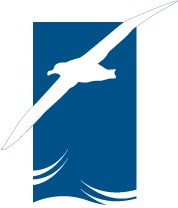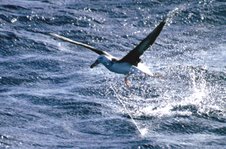Agreement on the Conservation of Albatrosses and Petrels facts for kids

Logo of the Conservation of Albatrosses and Petrels
|
|
| Abbreviation | ACAP |
|---|---|
| Formation | 1 February 2004 |
| Type | International organization |
| Purpose | Conservation |
| Location | |
|
Area served
|
International |
|
Membership
|
13 state members |
|
Executive Secretary
|
Christine Bogle |

The Agreement on the Conservation of Albatrosses and Petrels (ACAP) is an international agreement. It helps protect some of the world's most amazing seabirds. This agreement was signed in 2001. It officially started on February 1, 2004. That's when South Africa became the fifth country to join.
ACAP was created to stop the big drop in seabird numbers. This was especially true for albatrosses and petrels in the Southern Hemisphere. These birds face many dangers. They are threatened by animals brought to their breeding islands. They are also harmed by pollution. A big problem is getting caught by accident in fishing gear. This is called bycatch. It happens with longline, trawl, and gillnet fisheries.
The agreement asks countries to take action. They need to reduce bycatch. They must also protect the birds' breeding colonies. Plus, they need to control or remove harmful animals from these breeding spots. This is very important on islands.
Today, ACAP protects all albatross species. It also covers seven Southern Hemisphere petrel species. And it protects two shearwater species. ACAP's work shows that more and more countries want to help these birds.
How ACAP Works
ACAP has an Executive Secretary named Christine Bogle. She leads the team. She gets help from a Science Officer, Wiesława Misiak. There's also an Information Officer, John Cooper. The main office is in Hobart, Tasmania, Australia.
The agreement started on February 1, 2004. Countries that are part of ACAP send representatives to meetings. They meet regularly to discuss how to protect the birds. So far, there have been six big meetings. The next one will be in Australia in 2022.
Here are the places and dates of past main meetings:
| Location | Date |
|---|---|
| Hobart, Australia | 10-12 November 2004 |
| Christchurch, New Zealand | 13-17 November 2006 |
| Bergen, Norway | 27 April - 1 May 2009 |
| Lima, Peru | 23-27 April 2012 |
| Santa Cruz de Tenerife, Spain | 4-8 May 2015 |
| Skukuza, South Africa | 7-11 May 2018 |
ACAP also has an Advisory Committee. This group gives expert advice. They have met eleven times. Their last meeting was in Brazil in 2019. This committee has smaller groups. These groups focus on bird types, fishing bycatch, and how many birds are left.
You can find meeting plans and reports online. Just visit the ACAP website at www.acap.aq. Due to travel problems from the COVID-19 pandemic, some meetings were moved. The next Advisory Committee meeting will be in Ecuador in 2021.
ACAP's work is paid for by the countries that are members. These funds help run the office and hold meetings. They also support projects to save birds. This includes small grants and exchange programs.
What ACAP Does
ACAP helps countries create plans to save specific bird species. It helps them control animals that don't belong on breeding islands. These animals can harm the birds. ACAP also helps put in place ways to reduce seabirds getting caught in fishing nets. It supports research on how to best protect petrels and albatrosses.
To do this, ACAP publishes helpful guides. These include species assessments and factsheets. They also have guidelines for keeping breeding sites safe. This includes how to remove harmful animals. And how to move birds safely to new places.
One of ACAP's main jobs is to give advice. They tell fishing managers how to stop seabirds from being caught by accident. This advice is for both local and international fishing areas.
In May 2019, the ACAP Advisory Committee said there's still a big problem. Thousands of albatrosses, petrels, and shearwaters die each year. This is often because of fishing. To make more people aware, ACAP started World Albatross Day. It happens every year on June 19. This is the day the agreement was signed in 2001.
Species ACAP Protects
ACAP lists 31 species that it works to protect. These include many types of albatrosses, petrels, and shearwaters.
- Albatrosses
- Northern Royal Albatross (Diomedea sanfordi)
- Southern Royal Albatross (Diomedea epomophora)
- Wandering Albatross (Diomedea exulans)
- Antipodean Albatross (Diomedea antipodensis)
- Amsterdam Albatross (Diomedea amsterdamensis)
- Tristan Albatross (Diomedea dabbenena)
- Sooty Albatross (Phoebetria fusca)
- Light-mantled Albatross (Phoebetria palpebrata)
- Waved Albatross (Phoebastria irrorata)
- Short-tailed Albatross (Phoebastria albatrus)
- Laysan Albatross (Phoebastria immutabilis)
- Black-footed Albatross (Phoebastria nigripes)
- Atlantic Yellow-nosed Albatross (Thalassarche chlororhynchos)
- Indian Yellow-nosed Albatross (Thalassarche carteri)
- Grey-headed Albatross (Thalassarche chrysostoma)
- Black-browed Albatross (Thalassarche melanophris)
- Campbell Albatross (Thalassarche impavida)
- Buller's Albatross (Thalassarche bulleri)
- Shy Albatross (Thalassarche cauta)
- White-capped Albatross (Thalassarche steadi)
- Chatham Albatross (Thalassarche eremita)
- Salvin's Albatross (Thalassarche salvini)
- Petrels and shearwaters
- Southern Giant Petrel (Macronectes giganteus)
- Northern Giant Petrel (Macronectes halli)
- White-chinned Petrel (Procellaria aequinoctialis)
- Spectacled Petrel (Procellaria conspicillata)
- Black Petrel (Procellaria parkinsoni)
- Westland Petrel (Procellaria westlandica)
- Grey Petrel (Procellaria cinerea)
- Balearic Shearwater (Puffinus mauretanicus)
- Pink-footed Shearwater (Ardenna creatopus)
Countries That Are Members
Here are the 13 countries that are part of the ACAP agreement:
 Argentina
Argentina Australia
Australia Brazil
Brazil Chile
Chile Ecuador
Ecuador France
France New Zealand
New Zealand Norway
Norway Peru
Peru South Africa
South Africa Spain
Spain United Kingdom
United Kingdom Uruguay
Uruguay
Some countries, like Canada, Namibia, and the USA, often send observers to ACAP meetings. But they haven't officially joined the agreement yet. Japan and Mexico have also sent people to some meetings. Chinese Taipei has attended as a member of the Asia Pacific Economic Forum.
Any country that has albatrosses or petrels, or whose fishing boats might catch them, can join the agreement. Also, international and national groups that are not governments (NGOs) can ask to attend ACAP meetings as observers.
See also
- Bonn Convention

